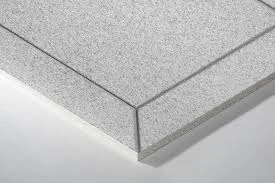Nov . 29, 2024 21:59 Back to list
fiber ceiling materials
Understanding Fiber Ceiling Materials A Comprehensive Guide
In contemporary architectural design, the choice of ceiling materials plays a significant role in the aesthetics, acoustics, and functionality of a space. Among various options, fiber ceiling materials have emerged as a popular choice for both commercial and residential applications. This article delves into the characteristics, benefits, and applications of fiber ceiling materials.
What Are Fiber Ceiling Materials?
Fiber ceiling materials are primarily composed of natural or synthetic fibers that are designed to enhance the acoustic and visual qualities of a space. These materials can be found in various forms, including tiles, panels, and suspended ceiling systems. The fibers used can range from mineral wool and fiberglass to cellulose, making them diverse in terms of appearance and performance.
Key Characteristics
1. Acoustic Performance One of the most significant advantages of fiber ceiling materials is their excellent acoustic properties. The porous nature of these materials allows them to absorb sound waves, reducing noise levels significantly. This quality makes fiber ceilings particularly suitable for environments where quiet is essential, such as offices, schools, and healthcare facilities.
2. Aesthetic Versatility Fiber ceilings come in various textures, colors, and patterns, offering designers a wide range of options to complement any interior style. Whether aiming for a modern or traditional look, fiber ceiling materials can be customized to meet specific aesthetic preferences.
3. Ease of Installation Many fiber ceiling materials are designed for quick and easy installation. Lightweight tiles and panels can often be installed in suspended ceiling grid systems or directly affixed to existing surfaces, reducing labor time and costs.
4. Sustainability Eco-conscious consumers appreciate fiber ceiling materials made from recycled or sustainable materials. Many manufacturers prioritize environmentally friendly practices, using renewable resources and non-toxic adhesives in their products.
fiber ceiling materials

5. Durability and Maintenance Fiber ceiling materials are generally durable and resistant to wear and tear. Some are also designed to be moisture-resistant, making them suitable for areas prone to humidity. Cleaning and maintaining these ceilings typically require minimal effort, ensuring they remain visually appealing over time.
Applications
The versatility of fiber ceiling materials allows for their application in various settings
- Commercial Spaces Offices, retail stores, and restaurants utilize fiber ceilings to create inviting atmospheres while controlling sound. In open office designs, these ceilings help minimize distractions, fostering productivity.
- Educational Institutions Schools and universities benefit from fiber ceiling materials due to their sound-absorbing qualities, which aid in creating focused learning environments.
- Healthcare Facilities Hospitals and clinics often deploy fiber ceilings to meet strict acoustic standards, crucial for patient comfort and communication between staff.
- Residential Interiors Homeowners are increasingly opting for fiber ceiling materials in living spaces, kitchens, and bathrooms, capitalizing on their aesthetic appeal and performance attributes.
Conclusion
Fiber ceiling materials are a formidable choice for anyone looking to enhance their interior environments. With a perfect blend of acoustic performance, aesthetic flexibility, and sustainability, these materials cater to a wide range of applications across various sectors. As architectural trends evolve, fiber ceilings stand out as a practical and stylish option for modern designers and homeowners alike. Transitioning to fiber ceiling materials not only improves the overall look and sound quality of a space but also reflects a commitment to sustainability and innovation in design. Whether renovating a home or designing a new commercial building, the benefits of fiber ceiling materials are indisputable; they offer a harmonious blend of form and function that can elevate any interior.
-
Quality Ceiling Trap Doors & Access Panels | Easy & Secure AccessNewsAug.30,2025
-
Durable Ceiling T Grid Systems | Easy InstallationNewsAug.29,2025
-
PVC Gypsum Ceiling: Durable, Laminated Tiles for Modern SpacesNewsAug.28,2025
-
Pvc Gypsum Ceiling Is DurableNewsAug.21,2025
-
Mineral Fiber Board Is DurableNewsAug.21,2025
-
Ceiling Tile Clip Reusable DesignNewsAug.21,2025







